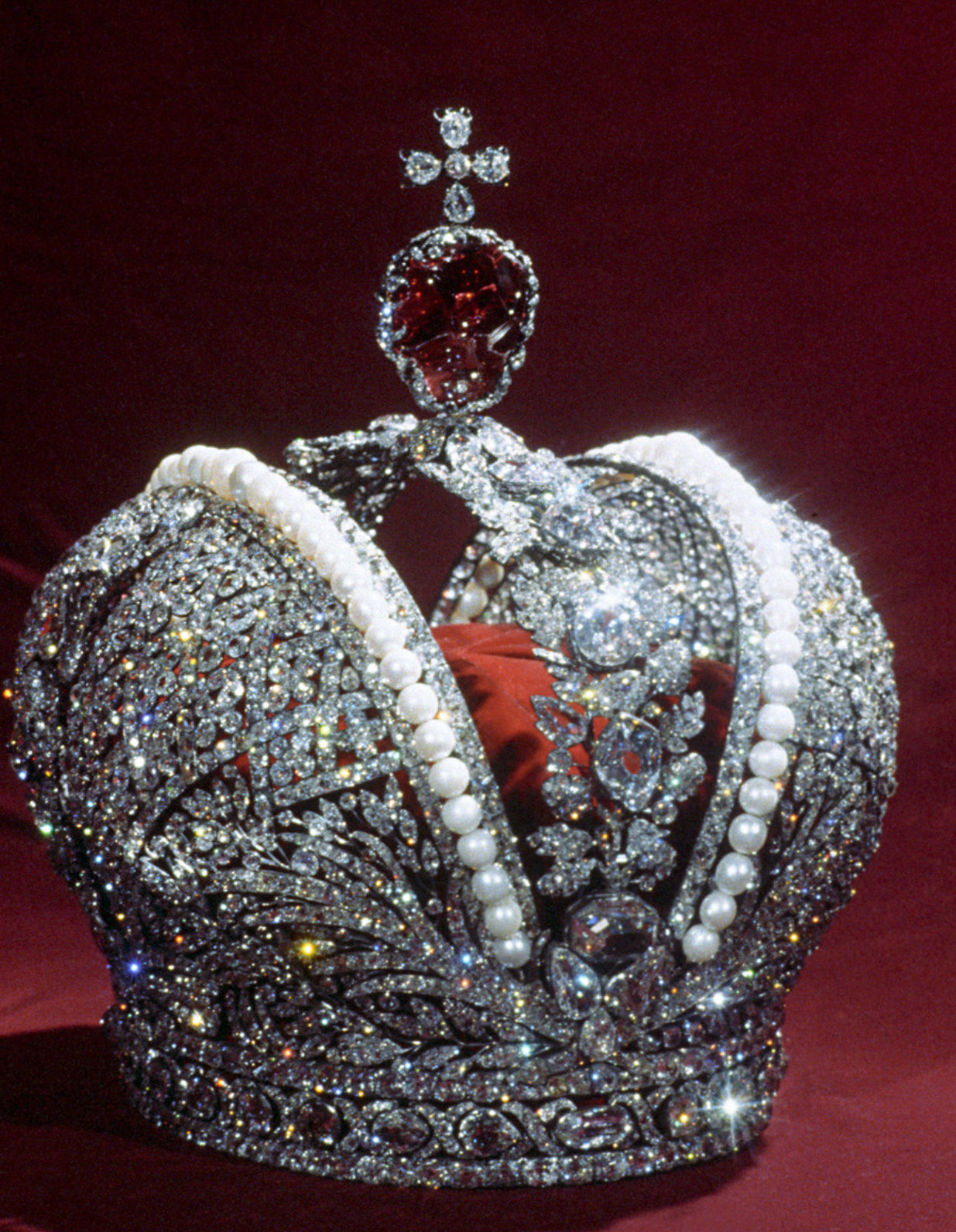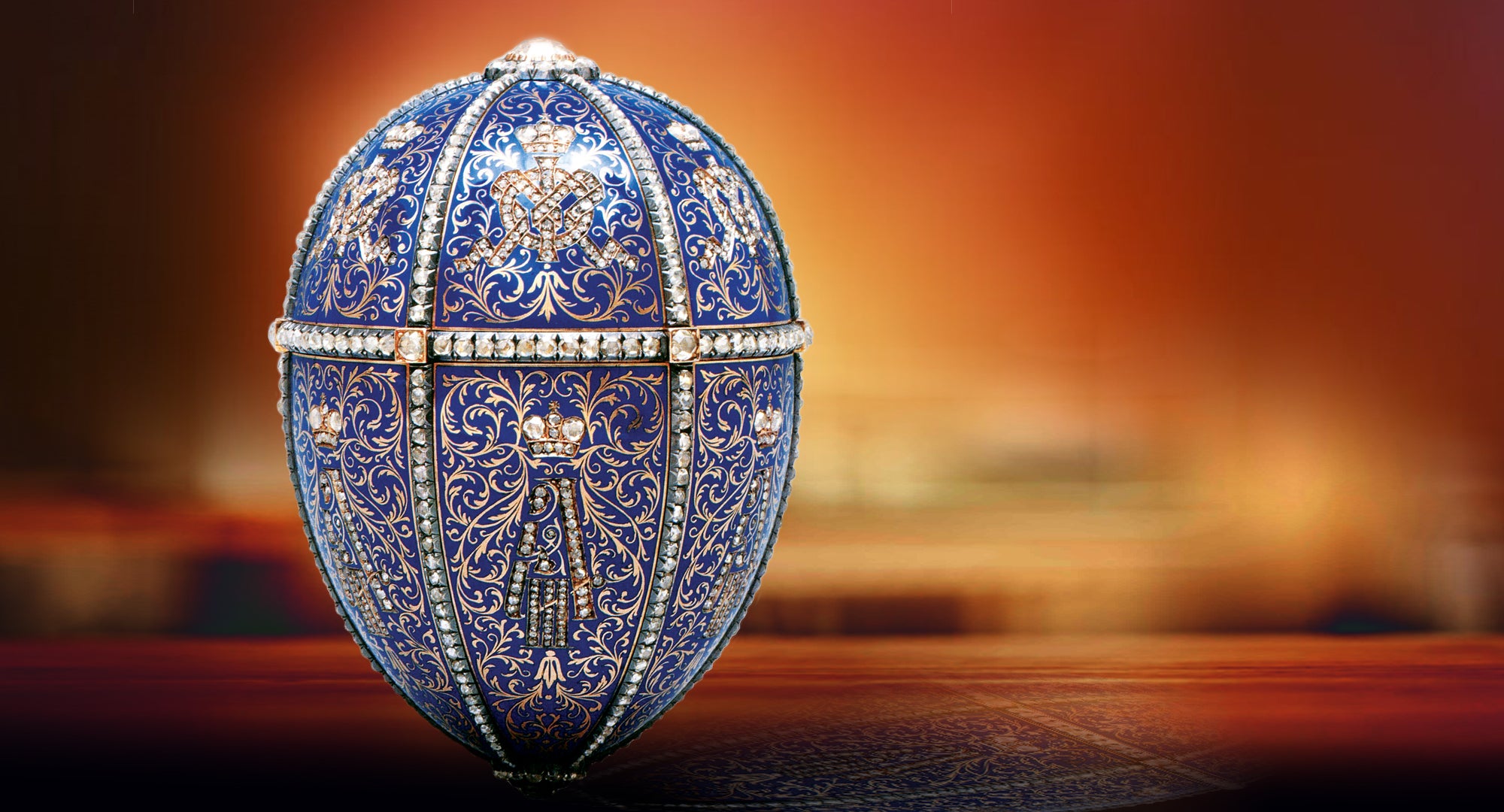Article: Regal Radiance: The Resplendent Jewels of Russia’s Romanov Dynasty

Regal Radiance: The Resplendent Jewels of Russia’s Romanov Dynasty
The Russian Imperial Jewels, a trove of exquisite treasures beyond imagining, represent a dazzling legacy of the immeasurable wealth and power of the Romanov dynasty. Crafted by master artisans and adorned with some of the world’s most precious gemstones, each jewel in this remarkable collection tells the story of a family renowned for their opulent and extravagant lifestyle, inspiring generations with their splendor.
From the resplendent Imperial Crown of Russia and other imperial regalia to the multitude of tiaras, earrings, brooches, necklaces, bracelets and rings, each piece in the collection holds a unique significance, reflecting the artistry, history and cultural heritage of the Russian Empire.
 Grand Duchess Maria Pavlovna, wife of Vladimir Alexandrovich, second son of Russian Emperor Alexander II, is considered one of the most important jewelry collectors in history.
Grand Duchess Maria Pavlovna, wife of Vladimir Alexandrovich, second son of Russian Emperor Alexander II, is considered one of the most important jewelry collectors in history.
Here, we embark on a journey through the glittering world of the Russian Imperial Jewels, as we delve into the craftsmanship, history and allure of several significant pieces from the collection, each a testament to the magnificence of the Romanov era.
The Imperial Crown of Russia (Great Imperial Crown)
The Imperial Crown of Russia, also known as the Great Imperial Crown, stands as a quintessential symbol of the Russian Empire’s authority and grandeur. It was crafted in 1762 for the coronation of Catherine II, most commonly known as Catherine the Great, who ascended to the throne as Empress of Russia from 1762–1796 after the tumultuous events surrounding her husband Peter III’s reign.

Known for her appreciation of art, culture and luxury, and for significantly advancing Russia in these ways, Catherine the Great was instrumental in shaping the visual identity of the Russian monarchy through various artistic endeavors, including the commissioning of important jewels such as the crown.
This exquisite piece was created by French master jewelers Jérémie Pauzié and Gérard-François Eckart, who were also court jewelers. Although challenging to confirm, additional master jewelers have also been associated with its creation, including Ivan Orlov, Ivan Yestifeev and Ivan Lipman Zolot.

The crown was designed with 4,936 diamonds totaling 2,858 carats. It features two separate halves of diamond-detailed metalwork, the edges of which are lined with 75 very fine, large, natural white pearls from India. The two halves rest on a circlet of 19 large diamonds, all averaging more than five carats in weight. The largest, a pear-shaped diamond from India, weighs more than 12 carats.
The arch between the two halves is designed with a motif of oak leaves and acorns made of small diamonds surrounding several significant diamonds in various shapes and sizes. At the apex of the arch is a magnificent red spinel weighing 398.72 carats—reportedly the largest red spinel in the world—surmounted by a diamond cross. Its crimson velvet cap, a hallmark of Russian imperial regalia, adds a regal touch to the ensemble.

Russian Empress Catherine II, most commonly known as Catherine the Great, wearing the the Imperial Crown of Russia.
The Imperial Crown of Russia was utilized in the coronations of every Russian monarch from Catherine the Great to Nicholas II. Nicholas II ruled as Emperor of Russia from 1894 until his abdication in 1917, an event that ultimately led to the downfall of the monarchy.
Today, the crown is the highlight of the Diamond Fund collection on display at the Kremlin Armoury in Moscow, where its exemplary design and craftsmanship reflect the power and prestige associated with the Russian monarchy.
The Orb
The Orb served as a symbol of divine right to rule and was often carried by the reigning Russian monarch during coronation ceremonies and other state occasions. It was crafted in 1762 for the coronation of Catherine the Great by Eckart, with additional work completed in 1797 by master jeweler Y. Duval.
The Orb is made of smoothly polished gold embellished with belts of diamonds set in silver, including a large rose-cut diamond weighing approximately 46.92 carats set prominently on its surface.

Additionally, the Orb is adorned at its apex with a substantial blue sapphire from Ceylon (modern-day Sri Lanka) weighing 195 carats. The stunning stone is framed by a halo of diamonds and surmounted by a diamond cross, further enhancing its opulence and splendor.
Today, the Orb, part of the Diamond Fund collection, is displayed alongside the Imperial Crown of Russia at the Kremlin Armoury in Moscow, where it stands as a cherished artifact of Russia’s imperial history.
The Scepter
The Scepter, also serving as a symbol of the divine right to rule, was often held by the reigning Russian monarch during coronation ceremonies and other state events. It was created between 1771 and 1773 and is a testament to the exquisite craftsmanship of its creators, master jewelers L. Pfisterer and I. Leonovich.
Constructed primarily of gold and silver, the scepter showcases the renowned Orlov diamond, weighing an impressive 189.62 carats. This magnificent diamond, known for its exceptional clarity and brilliance, serves as the focal point of the scepter, adding to its radiance and opulence.

In addition to the Orlov diamond, the scepter features an assortment of smaller diamonds intricately set along its length, enhancing its majestic allure. The meticulous attention to detail is further showcased through the incorporation of delicate enamel work, adding vibrant colors to the design.
Today, the Scepter, part of the Diamond Fund collection, is displayed alongside the Imperial Crown of Russia and the Orb at the Kremlin Armoury in Moscow as a treasured relic of Russia’s imperial heritage.
The Agraffe
This mantle clasp (or Agraffe, as it’s referred to at the Kremlin Armoury in Moscow), is an outstanding piece of Russian imperial jewelry that was used as a decorative fastening device to secure the imperial mantle (cloak) around the shoulders during coronations.
According to the Kremlin Armoury, the Agraffe was crafted in the mid-18th century by master jewelers J. A. Dubyulon and M. Ratsev, although other accounts attribute its creation to Pauzié.

Made of gold and silver, the Agraffe features intricate scrollwork and floral motifs emblazoned with sparkling diamonds. Its exquisite craftsmanship and luxurious materials made it a prized possession in the imperial jewelry collection.
After the Russian Revolution in 1917, the Agraffe, along with other treasures of the Romanov family, was confiscated by the Bolsheviks and eventually sold or dispersed. Today, it has been preserved alongside the Imperial Crown of Russia, the Orb and the Scepter as part of the Diamond Fund collection at the Kremlin Armoury in Moscow, captivating admirers with its beauty and historical significance.
Small Imperial Crown
The Small Imperial Crown holds its own significance within the array of Russian imperial regalia. Designed by Zeftigen, the crown was created in 1855 for the coronation of Empress Maria Alexandrovna, wife of Emperor Alexander II, who ruled Russia from 1855–1881.

Unlike its larger counterpart, the Imperial Crown of Russia, the Small Imperial Crown has a more delicate charm, yet still exudes the elegance and opulence of the Romanov era with its dazzling array of diamonds. The use of rose-cut diamonds, with their distinctive faceting resembling the petals of a rose, adds a unique and exquisite touch to the crown’s overall aesthetic.
Today, the Small Imperial Crown is preserved alongside the Imperial Crown of Russia, the Orb, the Scepter and the Agraffe as part of the Diamond Fund collection at the Kremlin Armoury in Moscow, offering a glimpse into the spendlor of the Russian Imperial jewels.
Kokoshnik Diadem
One of the most prevalent jewelry items at the Russian court until the early 19th century was the diadem, a headdress in the form of a “kokoshnik,” a traditional Russian headdress worn by women and girls for ceremonial and festive occasions. A kokoshnik features a semicircular or triangular shape and is elaborately decorated with beads, pearls, embroidery or sometimes even precious gemstones. It’s often worn tilted back on the head to frame the face and add elegance to traditional attire.
The diadem became referred to as “The Russian Tiara” in the West and gained popularity among leading jewelry houses such as Boucheron and Cartier.

Among the treasures in the Diamond Fund collection at the Kremlin Armoury in Moscow is the Kokoshnik Diadem, once owned by Empress Maria Feodorovna, the wife of Emperor Paul I, who ruled Russia from 1796–1801. Its breathtaking design epitomizes the diadem style, featuring a triangular arrangement of diamonds of various shapes, cuts and sizes.
Notably, many of the briolette-cut and elongated pear-shaped diamonds are movable, trembling and twinkling with the slightest turn of the head. At the heart of the composition rests a rare pale-pink diamond weighing 13.35 carats.
Grand Duchess Maria Alexandrovna’s Burmese Ruby Parure
Crafted by the esteemed Russian jeweler Bolin, this ruby and diamond parure stands as a further testament to the exquisite craftsmanship and regal grandeur of the Russian Imperial Jewels.

The opulent set was commissioned by Emperor Alexander II for the wedding of his daughter, Grand Duchess Maria Alexandrovna, to Prince Alfred, Duke of Edinburgh, the second son of Queen Victoria and Prince Albert of Saxe-Coburg and Gotha, on Jan. 23, 1874. It reportedly included a tiara, earrings, a necklace, a pendant, three brooches, a stomacher, a bracelet and a ring, each meticulously designed to showcase diamonds and untreated rubies from Burma of the finest quality and carat weight.
However, despite their illustrious origins, the current whereabouts of these magnificent pieces remain unknown, with speculation that the tiara may have been disassembled over time.
The Vladimir Tiara
The Vladimir Tiara is a magnificent piece of Russian imperial jewelry, crafted for Grand Duchess Maria Pavlovna to wear at her wedding to Grand Duke Vladimir Alexandrovich, second son of Emperor Alexander II, on Aug. 28, 1874.

It was made by the Russian court jeweler Bolin and is renowned for its intricate design and exquisite craftsmanship. The tiara features interwoven loops adorned with large cushion-shaped diamonds, set in gold and silver. Suspended from each loop is a large natural white pearl drop of the finest quality.
Following the Russian Revolution in 1917, the tiara was reportedly smuggled out of Russia by a British diplomat and eventually acquired by the noble Wernher family. Lady Zia Wernher, wife of Sir Harold Wernher, inherited the tiara and later sold it to Queen Mary, wife of King George V of the United Kingdom.

Since then, the Vladimir Tiara has become part of the British Crown Jewels. It was a particular favorite of Queen Elizabeth II, who would at times wear the tiara with emerald drops instead of the pearls, continuing its legacy of grace and elegance.
Colombian Emerald and Diamond Brooch
In addition to the 189.62-carat Orlov Diamond that graces the Scepter, another historic gem from the Russian Imperial Jewels is this exceptional dark-green Colombian emerald with a slightly bluish tint weighing 136.25 carats.
The striking rectangular-shaped emerald serves as the centerpiece of a brooch crafted in the second quarter of the 19th century. Once owned by Grand Duchess Alexandra Iosifovna, wife of Grand Duke Konstantin Nikolayevich, the jewel exudes elegance with its design—a delicate garland of stylized vine leaves interspersed with large round diamonds.

The emerald’s intriguing history adds to its allure: Said to have been unearthed during the Middle Ages, the gem resided in one of Colombia’s temples until the era of the conquistadors when it made its journey to Europe.
Today, the Colombian emerald and diamond brooch is displayed at the Kremlin Armoury in Moscow as part of the Diamond Fund collection, where this important emerald can continue to be acknowledged and admired.
Empress Marie Feodorovna’s Sapphire Brooch
In 1866, the Prince and Princess of Wales (later King Edward VII and Queen Alexandra of the United Kingdom) presented this sapphire, diamond and pearl brooch to Alexandra’s sister, Marie Feodorovna, on her marriage to Emperor Alexander III of Russia. It’s described as featuring a cabochon blue sapphire surrounded by two rows of diamonds with a pearl drop suspended from a diamond collet.

Empress Marie Feodorovna had a special affection for blue sapphires, making this brooch a treasured possession. She managed to keep it in her possession even during the upheaval of the Russian Revolution in 1917, during which her son, Emperor Nicholas II, his wife, Empress Alexandra Feodorovna, and their five children were tragically executed, leading to the abolition of the Russian monarchy.

Following Empress Marie Feodorovna's passing in 1928, her daughters took charge of her extensive jewelry collection, opting to auction off many pieces. Among the interested buyers was Queen Mary of the United Kingdom, wife of the Empress’s nephew, King George V. She purchased the brooch and added it to her own illustrious jewelry collection.

Upon inheriting all of Queen Mary’s jewels, including the cherished sapphire brooch, Queen Elizabeth II, the former monarch of the United Kingdom and the other Commonwealth realms, began wearing it in the 1950s, selecting it for numerous significant occasions throughout her reign. As a lover of blue sapphires herself, the brooch held a special place in her personal collection of royal jewels.
Raspberry-Pink Tourmaline Pendant
In addition to historical gemstones such as the 136.25-carat Colombian emerald and the Orlov diamond, the Russian Imperial Jewels collection at the Kremlin Armoury in Moscow also includes many unusual gems such as this 260-carat tourmaline with a raspberry-pink hue that was fashioned into a pendant.
The tourmaline’s striking color and shape, which resemble a berry or a bunch of grapes, are fittingly accentuated with green enamel leaves and yellow gold vines.

Scientists believe the gem originated in Burma. Its journey is quite intriguing: Reportedly, it was kept in the treasury of King Rudolf II of Bohemia, who received it from his sister, the widow of French King Charles IX. During the war with the Swedes in 1648, the gem was captured in Prague and exported to Scandinavia, where it came into the possession of Queen Christina. Following her demise, the gem found its way to Stockholm. Swedish King Gustav III then presented the tourmaline as a gift to Catherine the Great during his visit to St. Petersburg in 1777.
The legacy of the Russian Imperial Jewels endures as a testament to the power and glory of the Romanov era. Though the empire may have faded into history, the brilliance of these exquisite jewels continues to shine brightly, captivating admirers from around the world.
From the majestic Imperial Crown of Russia to the charming tourmaline pendant, each piece tells a story of royal authority, immeasurable wealth and timeless beauty. As guardians of Russia’s rich cultural heritage, these jewels serve as reminders of a bygone era, preserving the legacy of the Romanov dynasty for generations to come.

